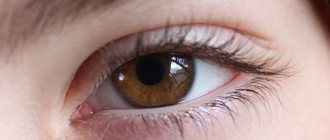Possible problems
Do colored lenses damage your vision? Not really. Deterioration of vision can occur after wearing contact lenses if it was associated with improper use and improper storage. It is advisable not to buy corrective lenses without consulting an ophthalmologist, since he will be the one who will help you choose them correctly. Independently choosing a pair increases the likelihood of micro-injuries to the cornea, causing lacrimation and redness of the eye, so you need to choose a size no larger, but no smaller. The deadlines indicated on the packaging must be strictly observed. Otherwise, wearing such lenses only causes harm and can even cause corneal swelling. It can arise because a person, for some reason, cannot or does not want to replace a pair, and the air flow to the cornea is significantly limited.
“Is it harmful to wear colored lenses?”
What do we know about eyes? Eye color depends on genetics. The more pigment on the iris, the darker the eyes; the less, the lighter. Brown eyes are a dominant gene, blue eyes are a recessive gene. This fact does not affect the quality of vision in any way. It has been scientifically proven that there is no relationship between predisposition to eye diseases and the color of the iris. Although there is such a topic called iridology, when the state of the iris can tell about a person’s illnesses, there are not many such doctors.
Some people have the congenital anomaly heterochromia: different iris colors in different eyes. This occurs due to insufficient concentration of melanin in the anterior layer of the iris in one eye. Famous people with heterochomy include: David Bowie, Alice Eve, Jane Seymour, Kate Bosworth, Henry Cavill, Mila Kunis and many others.
Now there is a very simple way to change the color of the iris - buy colored lenses. This “design” may seem hazardous to health compared to conventional lenses. But in fact, the risks of eye inflammation both when wearing regular and colored lenses are the same. Especially with long-term wear. This is especially noticeable to the surgeon who is contacted at our center for laser vision correction. According to international statistics, the risks from contact lenses (as well as wearing them incorrectly) are higher today than from the latest generation of laser vision correction. Even a soft contact lens placed on the eye exerts a certain pressure on the cornea, somewhat changing its curvature. This deformation persists for several days after lens removal. Therefore, we ask patients not to wear contact lenses for 2-3 days before surgery.
Long-term wearing of lenses causes thinning of the cornea and the growth of blood vessels where they should not be (keratocytes lose the ability to synthesize new tissue). This can occur even if the lenses are worn correctly after 3 to 5 years of use.
Infections that develop into erosions and ulcers. Daily lenses are less dangerous in terms of the development of infections than long-term lenses. For the latter, the main risk is poor cleansing, so the risk of infection is much higher - in science this is called bacterial keratitis (the lens essentially turns into a Petri dish for bacteria to multiply). In short, soft lenses are more dangerous in the long term: everything that is not one-day use is about 6 times more dangerous. So if your eyes begin to cloud while wearing lenses, then you need to immediately remove them, and if the symptom does not go away, then run to an ophthalmologist.
Incorrect wearing, or rather overwearing, of lenses and subsequent hypoxic changes are also dangerous for vision. Even the most oxygen-permeable soft lenses have a limit on how long they can be worn. Most often this is 8 hours (open the instructions for yours and check, this is important!). Often people put them on in the morning at 8 o'clock and then take them off around 10 pm. The result is a lack of oxygen, the growth of vessels from the limbal opaque zone (and there are usually no vessels in the cornea and should not be) and their penetration into the cornea. All this is fraught with unpleasant changes: for example, a significant decrease in vision. Just imagine that you will have to walk around in a plastic bag from 8 am to 10 pm. This is definitely an unhealthy condition. By the way, significant dryness in the eyes after removing lenses is also not good; it may be a sign of swelling. If this happens to you, then it is better not to wear lenses in the next two weeks. It is worth considering replacing them with glasses or making a correction.
The most modern and gentle correction method is ReLEx SMILE (Switzerland), recovery takes only one day. Or choose the latest personalized correction option Femto Lasik Custom Vue.
As for changing eye color, at the last ASLMS conference in the USA, IrexLaser technology was presented, which will help permanently change eye color from brown to blue, that is, lighten the pigment. But this is still a vast field for study.
When it comes to children...
Do colored lenses spoil the vision of the younger generation? When wearing contact lenses for small children, there are features that you should think about in advance; you cannot choose them only by the color you like. Before purchasing such a delicate item as lenses, a comprehensive examination by an ophthalmologist is necessary. The main feature is the formation of vision or its impairment. Eyeballs continue to grow until approximately 13-14 years of age. During this period, the curvature of the lenses changes. If improvements are noted, or vice versa, you will have to change the optical power of the products. To monitor the slightest fluctuations in the still completely unformed vision, you need to visit the doctor once every six months, but if complications arise, you will have to do this much more often. Lenses are a useful thing for children, allowing them to correct in time a disorder that has begun to form and restore clarity of vision. In some cases, doctors themselves prescribe them (myopia, hypermetropia, etc.). But a significant disadvantage is the price of the products and the fact that they will have to be changed relatively often.
Is the coloring pigment harmful?
The disadvantage that most people who wear clear lenses face is that they are difficult to distinguish in solution. You can order colored ones for your child. There is a myth that they are harmful to the eyes due to the presence of pigment. But that's not true. The coloring pigment is located inside the lens itself, between the polymer layers and does not come into contact with the cornea. You need to take into account the color of the child’s iris; for example, not every lens will cover a dark brown iris, and it won’t look very good. With a light iris, you can buy both tinted and completely covering the colored part of the eye. If the parents of a schoolchild are worried about the unnatural appearance of the eyes, then they can choose ones that completely match the natural color of the iris.
How to choose the best quality shades
Tinted lenses are purchased to obtain a unique shade by mixing the color of the product with natural ones, or to enhance the real color. Due to the fact that the color is not solid and does not completely cover the eye, it is more difficult to choose the right “glass”; the latter require care when choosing.
Find out about cheap lenses in this material.
Key points to pay attention to:
- Radius of curvature. In simple terms - how convex the lens is, as well as its diameter.
- Wearing mode - how long you can wear the product without taking it off.
- Expiration date - how often you need to replace the pair with a new one.
- Optical power.
Colors are as natural and natural as possible for brown-eyed people
Tinted options will not look impressive. It is better to take a dense, solid color. Then there will be no risk that the dark iris will shine through the loose color and distort it.
Light shades (for gray-eyed, blue-eyed and green-eyed)
Almost any color or shade will do. On a light background it is easy to get a beautiful color regardless of the layer applied and look impressive.
Ultimately, you always need to rely on the color of your iris. There is never a perfectly pure color.
How many hours can I use?
Do colored lenses spoil vision if it is 100 or more? With proper care and wearing, everything will be fine. In addition, the wearer’s appearance will change. But first things first. The main concern people have about the dangers of lenses is the fear of paint getting on the cornea. This, of course, won't happen. The time they are worn will directly depend on the air exchange with the eyeball. The recommended wearing time is no more than six to eight hours, sometimes up to 24 hours, but this depends on the manufacturer.
conclusions
Colored (multi-colored) can perform all the same functions as regular ones. According to the description, they come in several classes and types, depending on the purpose. Products from the world's top manufacturers cost reasonable money and are available to almost everyone. It is necessary to measure when purchasing to see if they can cover the shade of the eyes
This is especially important if you choose a model for dark eyes. There is no need to worry about hygiene; they are disinfected after each client. Selecting the right shade depends on your actual eye color. Taking it off and putting it on at home will become easier over time; the condition is constant practice. You need to take care of them carefully and remember that you can walk during the day and sleep at night only in those lenses that are indicated in the instructions.
In another case, it can be dangerous - this is written in the contraindications.
Color distortion
Another common misconception is the myth of color distortion. This is true, but only partly. In natural daylight, problems cannot arise, since the pupil remains narrow and a small transparent area is left in the center of the lens. An unpleasant surprise may already begin at night. The fact is that in poor lighting, the pupil expands, going beyond the boundaries of the fields made specifically for it. One gets the impression that there is a veil before the eyes, of course, this can also be expressed in the form of interference before the eyes. And those who have experienced a similar effect are now wondering whether colored lenses spoil their vision, some even persistently dissuade them from purchasing, forgetting that the experience could have been sad because they did not go to an ophthalmologist and did not consult
Properties of beauty lenses
Beauty lenses have several properties: give a slight tint, completely change the color of the iris, or add shine to the eyes. The choice is made depending on how much a person wants to transform. It is advisable to select products according to color type, otherwise the eyes will seem unnatural. Then, instead of a wonderful addition to the image, the person will get a ridiculous look. Therefore, you need to approach color carefully. Examples of lenses selected by color: for blondes - blue, for brown-haired women - green, golden brown, for brunettes - blue, purple.
If the carrying limit is exceeded
A person with healthy vision can wear carnival lenses on the occasion of the holiday. But no more than three to four hours! Do colored lenses damage your vision? This can happen if the wearing limit is exceeded. After 4 hours, eye fatigue may develop. When worn for a long time, for example, like ordinary colored lenses for 6-8 hours, irritation and redness of the eyes develop, which, of course, is not very pleasant. You also need to take into account the size: starting from the outline of the iris, ending with the length of the entire eye (scleral).
Contraindications
Do colored lenses damage your vision and can you wear them? As with all pharmacological products, the product being studied has contraindications. In most cases, contraindications include acute and periodically developing chronic diseases. In the case of an acute form of the disease, for example, barley or conjunctivitis, wearing lenses will only aggravate the inflammation if it is not removed from the eye.
The most common eye lesion is blepharitis, divided into staphylococcal and seborrheic. The first causes epidermal ulcerations and chronic inflammation of the hair follicle. With the development of seborrheic blepharitis, the ciliary glands of Moll and Zeiss are affected. A characteristic symptom is fatty scales, yellowish in color, after their separation there are no ulcerations, as with staphylococcal. The list also includes marginal and posterior marginal blepharitis. These diseases do not prohibit the use of lenses during remission; during an exacerbation of two to three weeks, they cannot be worn.
It is strongly recommended not to wear contact lenses for people with dry eye syndrome, as in this condition tear production is impaired, resulting in intolerance to colored contact lenses. The use of lenses is not permissible in case of obstruction of the tear ducts. Then drug treatment is recommended, but surgical treatment is possible. Contact lenses are prescribed to a person with caution. having corneal dystrophy. Only the attending physician can prescribe them.
Poor tolerance occurs in those suffering from diabetes, pregnant and lactating women, during menopause, or in a dusty or heavily smoky room. If hygiene rules are not followed, an infection can enter the eyeball, not only complicating putting on lenses, but also leading to partial or complete loss of vision. Also, you should not buy lenses from unknown sites, but only in pharmacies and specialized optical stores.
Is it possible to try on different lenses when purchasing: conditions
It is necessary to try on lenses when purchasing; you can make a purchase without trying them on if it is not the first time and you know exactly what parameters the product should have. When you first buy them, you need to try them on; if there is no discomfort at first, then wear them for about an hour. Only after this will it be clear whether this option is suitable or not. If you do not carry out this procedure, then the selected option may turn out to be so inappropriate that there will be no point in using it.
Many people doubt the correctness of this procedure. If you let everyone try it on, then this is a serious violation of hygiene. But in this case, disinfection must be carried out after each user; storage is carried out in a special solution that reduces the risk of microbes surviving after disinfection. For people with serious illnesses, it is recommended that products be made to order. This will speed up the selection process and also prevent the spread of the disease.
Purpose
How do colored lenses affect vision and when can they be prescribed? Let's answer this question as well.
Contact lenses can be prescribed as a means of vision correction for the following purposes:
- Therapeutic: corneal damage, recent keratoplasty, eye protection after burns.
- In order to eliminate inconvenience. For some people, glasses interfere with harmonious work. These are professions such as builders, athletes, divers, etc. In such cases, contact lenses come to the rescue.
- A person with scars and scars or albinism can use lenses to hide the defect of the eye.
- To inhibit diseases of the organs of vision.
What it is?
Contact lenses are the thinnest elastic eye pads, the purpose of which is to correct vision. They are now considered a modern alternative to glasses. Colored lenses look similar in appearance, however, they perform only an aesthetic function, i.e. change eye color.
Initially, colored lenses were exclusively a carnival option: they were made in very exotic forms (cat's eye, without pupil, red eyes) for masquerades and holidays. Later, optics developed lenses that meet two requirements at once:
- elimination of refractive errors towards myopia or farsightedness using diopters;
- change in iris color.
Colored correction lenses consist of several layers. The inner layer contains a pigment that can enhance the natural color of the eyes or give them a completely new, sometimes unusual shade.
REFERENCE! The brightness of the color depends on the intensity and shutter speed.
At the same time, colored lenses with diopters do not have a uniform color: manufacturers very accurately recreate the pattern of the iris, which is why the eyes acquire a new shade or color intensity, but look natural.










